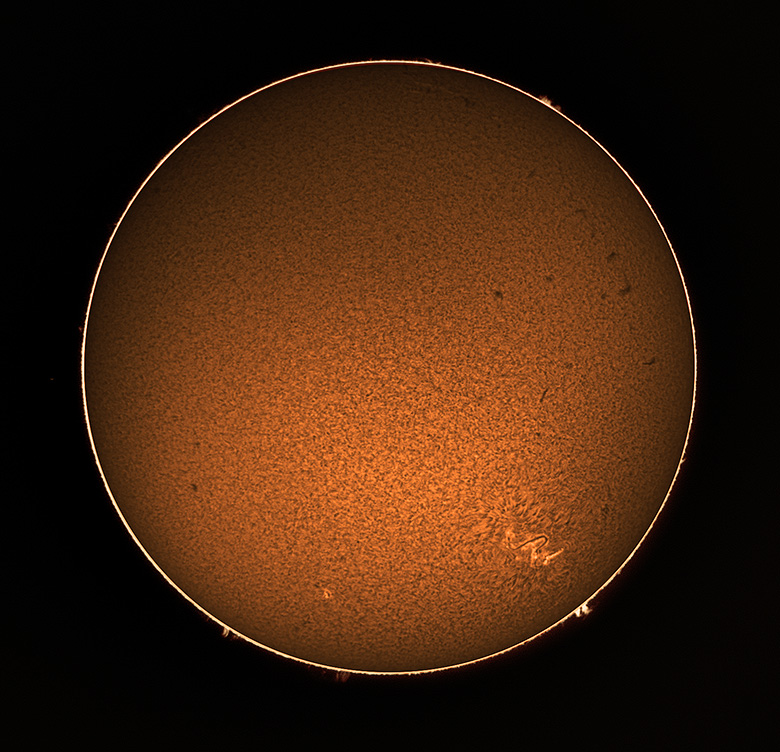|
7/11/2010. Amy
and I were supposed to be on Easter Island for today's total solar
eclipse. Joel Harris of Twilight Tours invited us along at a really
good rate, but in the end we just couldn't begin to justify dropping
so much money on one short trip. Instead, I'm watching the eclipse
via webcams at the Rapa Nui airport. A recent forecast was dreadful
but the skies in late afternoon, eclipse time, look much better
than predicted.
I went out into the yard this morning to create
my own eclipse. The air was very calm, the view very detailed.
I wanted to take advantage of the quiet air to try to get a good
photo of Active Region 11087. Today's photo is the first case of
my recording significantly more detail than I could see:

Lunt LS60Ha
with DS50 on A-P Mach1.
Canon 50D, barlow on EP extension tube. ISO 400.
4, 1/2 second exposures. Opened in Maxim DL, red plane isolated.
Aligned and added in Photoshop.
I did not see those bundles of spicules bending
in the magnetic fields away from AR11087. Focus is close today,
but I don't think I've quite nailed it. I had to use a pretty aggressive
unsharp mask to bring out all that this image reveals. Four images
with this exposure added in Photoshop used about half the dynamic
range available. I'm thinking eight, or maybe ten, selected for
sharpness, with focus dead on, would be close to ideal. This looks
to me like real progress. Here's a full-sun image with prominences
in honor of today's eclipse:

Lunt LS60Ha50DS
Canon 50D (un-modified), ISO 400.
Barlow lens on prime focus adapter.
4, 1/4-second exposures, opened in Maxim DL5, red Bayer plane
extracted
Aligned and added in Photoshop CS4. Rim histogram stretched to
reveal prominences.
Click the image for wallpaper-sized version.
Here are four frame grabs from a webcam overlooking
the sea from the main airport on Easter Island. The camera snaps
a frame every ten minutes. The auto exposure copes with the dimming
and brightening light so well that, for the most part, you can't
tell anything is happening. Luckily, one frame (at upper right)
was made during the four minutes and several seconds that the shadow
of the Moon covered the airport:

The next convenient solar eclipse is an annular
event on May 20, 2012, which will be visible from many of our favorite
parts of New Mexico:

An "annular" eclipse is not one that happens
every year; it's one that leaves an annulus, a ring, of the Sun's
photosphere shining in the sky. An annular eclipse is really "just" a
special kind of partial eclipse in which the Moon is too far away
to completely cover the Sun. At this one, the Moon will cover,
at most, 96% of the Sun. Annular solar eclipses are worth noting
and some are worth travelling to see, but unless they come very close
to covering the Sun, they're not the killer events that total solar
eclipses are. Paraphrasing Annie Dillard: a partial eclipse is
like riding in an airplane; a total eclipse is like falling out
of one. (That said, on May 30, 1984, an annular eclipse crossed
North Carolina and covered 99.9% of the Sun; it was the most beautiful
eclipse I've ever seen.)
A total eclipse on August 21, 2017, hits several
highlights in Wyoming (and also parts of many other states):

Click the maps for much larger JPEGs of these paths.
The central 80% or so of each path is stone reliable, but do NOT
rely on the edges. I made these maps by plotting the path of totality
in Guide 8 and then overlaying the path in Street Atlas. I tweaked
until all the cities lined up reasonably well which helped me to
make corrections for projections and scale, but I didn't do anything
rigorously enough to bet the farm that the northern and southern
limits are closer than several miles.
|